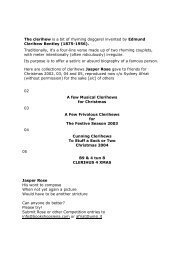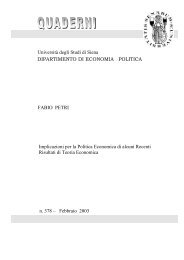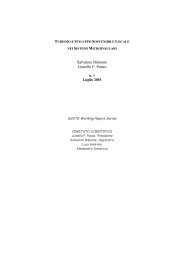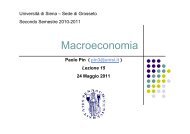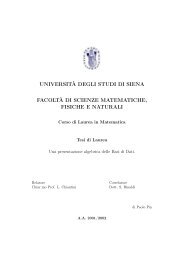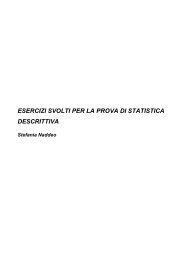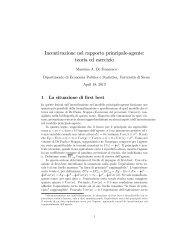Appunti delle lezioni di istituzioni di matematica attuariale per le ...
Appunti delle lezioni di istituzioni di matematica attuariale per le ...
Appunti delle lezioni di istituzioni di matematica attuariale per le ...
You also want an ePaper? Increase the reach of your titles
YUMPU automatically turns print PDFs into web optimized ePapers that Google loves.
Osservazione A.2.1. Le ipotesi della valutazione appena esposte non sono adeguate al caso<br />
italiano, dove la normativa impone che <strong>le</strong> gestioni separate abbiano un contenuto preva<strong>le</strong>ntemente<br />
obbligazionario. Modelli <strong>di</strong> mercato più adeguati sono <strong>per</strong>ò basati su processi stocastici<br />
molto più comp<strong>le</strong>ssi del moto Browniano geometrico, che rendono l’analisi molto più complicata.<br />
I risultati della valutazione che otterremo in questo contesto modellistico più semplice<br />
potranno tuttavia essere considerati una “prima approssimazione”. 24<br />
A.2.1 Il calcolo del fattore <strong>di</strong> valutazione<br />
Il calcolo del fattore <strong>di</strong> valutazione verrà condotto in due passi: verrà prima analizzato il caso<br />
t = 1 e poi il caso genera<strong>le</strong>.<br />
Lemma A.2.2. Se t = 1 si ha che<br />
dove<br />
V 0, Φ(0, 1) = 1 −r<br />
(1 − β) e + β N(d1) + (i + β)e<br />
1 + i<br />
−r N(−d2) , (215)<br />
d1 =<br />
<br />
r − log<br />
1 + i<br />
β<br />
σ<br />
<br />
+ 1<br />
2 σ2<br />
, (216)<br />
d2 = d1 − σ (217)<br />
e N è la funzione <strong>di</strong> ripartizione della <strong>di</strong>stribuzione norma<strong>le</strong> standard.<br />
Dimostrazione. Applicando la definizione <strong>di</strong> ρ1 e I1 e <strong>le</strong> proprietà dell’o<strong>per</strong>atore max, il payoff<br />
Φ(0, 1), esigibi<strong>le</strong> al tempo 1, può essere scritto nella forma<br />
Φ(0, 1) = 1 + ρ1<br />
= 1<br />
1 + i [1 + max(βI1 , i)]<br />
= 1<br />
<br />
1 + max β<br />
1 + i<br />
S1<br />
<br />
− β , i<br />
S0<br />
= 1<br />
<br />
<br />
S1<br />
1 − β + β max ,<br />
1 + i<br />
S0<br />
i + β<br />
<br />
β<br />
= 1<br />
<br />
1 − β +<br />
1 + i<br />
β <br />
max S1 , 1 + i<br />
β<br />
Per linearità il suo valore <strong>di</strong> mercato in zero è<br />
Posto<br />
V 0, Φ(0, 1) = 1<br />
1 + i<br />
S0<br />
<br />
(1 − β) e −r + β<br />
<br />
K =<br />
S0<br />
V<br />
<br />
0, max S1 ,<br />
1 + i<br />
<br />
β<br />
S0 ,<br />
<br />
S0<br />
<br />
1 + i<br />
β<br />
che è costante alla data <strong>di</strong> valutazione, <strong>per</strong> il corollario A.1.7 risulta<br />
.<br />
<br />
S0<br />
<br />
. (218)<br />
V 0, max(S1 , K) = S0 N(d1) + K e −r N(−d2)<br />
= S0 <br />
β N(d1) + (i + β) e<br />
β<br />
−r N(−d2) , (219)<br />
24 Per degli esempi <strong>di</strong> valutazione metodologicamente corretti si veda C. Pacati (2003), Financial Valuation of<br />
a New Generation Participating Life-Insurance Contract e G. Castellani, M. De Felice, F. Moriconi e C. Pacati<br />
(2005), Embedded Value in Life Insurance.<br />
c○ C. Pacati 2005, <strong>Appunti</strong> IMAAV, appen<strong>di</strong>ce (v. 26/12/2005) pag. 59



